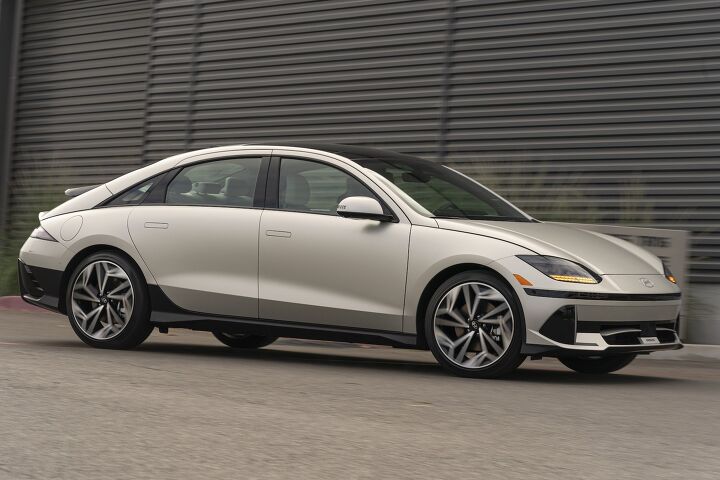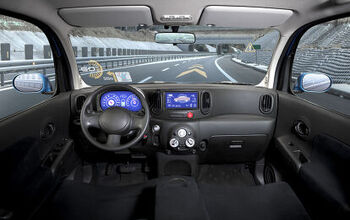The Right Spec: 2023 Hyundai IONIQ 6

The design studios at Hyundai are firing on all cylinders these days, ironic since some of the eye-popping vehicles they’re churning out don’t have any cylinders at all. The upcoming IONIQ 6 is one of ‘em, set to be offered in a number of trims and powertrain options.
Your author will ignore federal EV rebates in this post, partly because they can vary wildly depending on the circumstance but also because they cause his head to spin even worse than after his morning grog ration of Angel’s Envy whiskey. Sticking to MSRP, the least expensive trim is the SE Standard Range rear-wheel drive, equipped with a single 149 horsepower electric motor and a 53-kWh battery good for about 240 miles of driving on a full charge. This’ll ding yer bank account for $41,600.
Keeping in character for Hyundai, this model is bursting at the seams with content – even at its entry-level. Likely thanks to the economies of scale, the base trim still gets the dandy 800V architecture which can hoover up to 350kW of electricity from an appropriately robust Level 3 fast charger. This has the practical benefit of spending less time at public chargers during occasions when owners decide to dip off the highway for a jolt of electrons (and coffee while they wait).
Smart cruise control with stop-and-go capabilities, automatic headlight control, and enough LEDs to illuminate most of Las Vegas are all on this trim, along with heated side mirrors and flush door handles. These features have the ability to make the SE SR RWD look very much like its more expensive brethren. Colors can be a hot topic with EVs; get traditional white if you must but we feel expressive paint options are always a good bet.
Inside, look for comforts like power seats for the driver, heated chairs for both up-front occupants, and rear air vents for backseat ankle biters. Upholstery is cloth at this price, though the steering wheel does adjust for reach and rake whilst displaying a quartet of interactive pixel lights instead of a Hyundai logo. Fun fact: four dots indicate the letter H in Morse code. Dual automatic temperature controls keep warring factions at bay and there should be enough USB ports for everyone in the car – four USB-C and a USB-A.
Screen displays are top-tier, as they are in more expensive trims. Two 12.3-inch screens are part of the dashboard, one serving up critical vehicle information while the other handles navigation and infotainment. There are six speakers for the latter, plus wired smartphone integration and the expected Bluetooth gear. Over-the-air updates can be pushed to the car for whatever upgrades the mother ship feels are necessary. We can have that discussion another day.
Take the base trim, then? Not so much. It’s only a $3,900 walk to the next level trim (confusingly also called SE but dropping the ‘Standard Range’ suffix) but it brings more power and more range. Total output climbs to 225 horses, a 50 percent jump, and range vaults to an estimated 361 miles thanks to a 77.4-kWh battery pack. Note this is still a rear-wheel drive car (all-wheel drive costs a further $3,500).
Another big bonus with this trim is the inclusion of a heat pump, a type of technology that uses less electricity to warm the cabin than a relatively old-school resistive heater. For a sum of $45,500, this trim is our pick.
[Image: Hyundai]
Become a TTAC insider. Get the latest news, features, TTAC takes, and everything else that gets to the truth about cars first by subscribing to our newsletter.

Matthew buys, sells, fixes, & races cars. As a human index of auto & auction knowledge, he is fond of making money and offering loud opinions.
More by Matthew Guy
Latest Car Reviews
Read moreLatest Product Reviews
Read moreRecent Comments
- ToolGuy This number here keeps going up. Oh look it went up again.
- IBx1 It’s clear they smash these into walls front and rear before they leave the factory, so what do they build that wall out of to achieve such consistent results?
- THX1136 You folks did read the article, right? 7 stations have been built so far (not near enough of course) which equals 18 chargers (not near enough either). Still agree with jkross - the government rarely does things exceptionally well. This is but one more example.
- Carson D I disagree. Biden's graft is allowing his biggest donors to pay for all of the pro-Hamas protests 'spontaneously and organically' popping up on college campuses across the country.
- JTiberius1701 Well we are speaking of Miami Beach...



































Comments
Join the conversation
Hellen Keller approved!
I just looked at the Hyundai website and it appears the SE SR trim has gone away. The SE is now the base trim at $45,500.